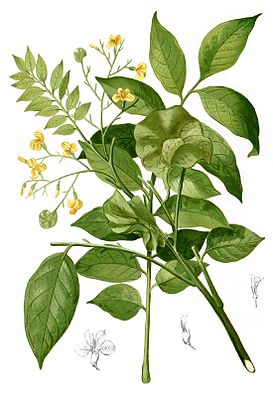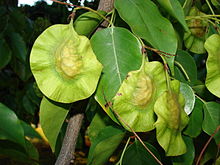Fool tree
| Fool tree | ||||||||||||
|---|---|---|---|---|---|---|---|---|---|---|---|---|

Narrabaum ( Pterocarpus indicus ) |
||||||||||||
| Systematics | ||||||||||||
|
||||||||||||
| Scientific name | ||||||||||||
| Pterocarpus indicus | ||||||||||||
| Willd. |
The Narrabaum ( Pterocarpus indicus ) is a species of the genus Pterocarpus in the subfamily of the butterflies (Faboideae). The tree species is native to tropical Asia and the Pacific islands.
description

Appearance and leaf
The Narrabaum grows as a deciduous tree that reaches heights of between 20 and 25 meters or more. The chest height diameter can be up to 2 meters. The relatively smooth bark is grayish-brown. The wood and bark lead to a red cinema .
The alternate leaves arranged on the branches measure 15 to 30 centimeters and are unpinnate. The five or seven (in exceptional cases up to 11 or only one) leaflets are arranged alternately to almost opposite to one another on the leaf thachis. Both the rachis and the 4 and 7 millimeter long stalks of the leaflets are glabrous. The thin and paper-like leaves, bare on both sides, are ovoid to elliptical with a length of 5 to 11 centimeters and a width of 3.5 to 5.5 centimeters with a wedge-shaped to rounded base and a pointed upper end. The pinnate leaf nerve consists of six to eight pairs of lateral nerves , the central vein is slightly depressed on the top and raised on the underside. The mostly small stipules fall off early.
Inflorescence and flower
The flowering period in China extends from March to April. The mostly axillary, rarely terminal, racemose or paniculate inflorescences are 10 to 18 centimeters long and slightly downy hairy.
The butterfly flowers measure between 1 and 1.5 centimeters. At the base of the calyx there are two linear, elongated bracts . The flower stalks measure 7 to 10 millimeters. The cup is bell-shaped and between 4 and 6 millimeters in size. The hair is pressed and brown with a silky texture. The calyx teeth are broadly triangular and about 1 millimeter long. two calyx teeth are enlarged compared to the others.
The five yellow to orange or red petals are long nailed . The flag is oval-round with a curled edge. The wings are elongated and about as long as the flag. The shuttle is narrow, elongated and shorter than the wings.
The ten stamens are fused to two groups (9 + 1) over a length of 8 to 9 millimeters. The stamens are of different lengths with movable anthers. The short-stalked and upper permanent ovary is hairy elongated and tightly fluffy at a length of 7 to 8 mm, it contains two ovules . The curved stylus ends in a minimal scar .
Fruit and seeds
The solitary, non-opening legumes ( wing fruits ) are round and measure 4 to 4.5 centimeters in length and 3.5 to 4.5 centimeters in width. They are short-stalked, slightly hairy and winged in the middle. The wings measure up to 2 centimeters. The red-brown, flat seeds are oblique crescent-shaped. The fruits ripen in China between April and May.
Ingredients and chromosome number
Narra wood contains the red dyes narrin (C 15 H 13 0 5 ), santalin (C 54 H 28 O 16 ) and angolensin (C 16 H 16 O 4 ). Narrin is a dark red, amorphous powder that releases phloroglucinol and resorcinol in basic compounds .
Further ingredients are pterocarpine , pterostilbene , homo-pterocarpine , prunetin , formononetin , isoliquiritigenin , hydroxyphenylpropionic acid , pterofuran , pterocarpol and β-eudesmol . When distilled, the wood produces a tar with a moderate density. If wood chips are put in water, the water changes color with beautiful blue and yellow streaks.
The number of chromosomes is 2n = 20.
Occurrence and endangerment
The distribution area of the Narrabaum is mainly in tropical Asia in the states of Cambodia , Thailand , Myanmar , Malaysia , East Timor , Indonesia , the Philippines , the People's Republic of China and Japan as well as on the Pacific islands : Palau , Micronesia and Vanuatu .
The Narrabaum thrives at altitudes between near sea level to about 1300 meters. Pterocarpus indicus mainly grows in evergreen forests, it can also be found on creeks and rocky seashores.
The International Union for Conservation of Nature and Natural Resources (IUCN) classifies the type Pterocarpus indicus on its Red List of Threatened Species as endangered ( vulnerable ) a. The species is already extinct in Vietnam. Despite an intensive search, not a single wild specimen could be found in Sri Lanka and Malaysia. The main reason for the endangerment is the intensive felling of the trees for wood production.
Another potential risk arises from the spread of infestation on trees by the fungus Fusarium oxysporum, which causes Fusarium wilt .
Taxonomy
The first description of Pterocarpus indicus was in 1802 in the fourth edition of Carl Ludwig von Willdenow's Species Plantarum .
ecology
The Narrabaum is pollinated by a large number of different bees (Apiformes) from different genera . Other possible pollinators are Parasa lepida, a species of butterfly (Lepidoptera) and the beetle (Coleoptera) Hypomyces squamosus .
The seeds are eaten by wild boars ( Sus scrofa ). Furthermore, fungi regularly grow on the trees, especially the lackporling species ( Ganoderma ) Ganoderma pseudoferreum and the shiny lackporling ( Ganoderma lucidum ). But the common split-leaved leaf ( Schizophyllum commune ) and the species Sclerotium rolfsii also regularly infest the narrabea.
use
The fool tree is cultivated mainly because of its wood, the wood is important locally in the distribution area as well as for export . It is used for furniture, interior decoration and in boat building . The wood has excellent technical properties; it has a moderate density of 750 to 900 kg / m³ at 10% rel. Humidity. A very highly valued form of wood are its burl bulbs, which usually grow above the ground on the trunk, whose finely grained, dark red, dense wood as amboina grain has always achieved very high prices. Veneers made from amboina grain are by far the most expensive woods in the global timber trade.
Wood
In Papua New Guinea , narra is a major commercial timber that fetched high prices. The export of logs is prohibited and only processed wood may be exported.
In the Philippines, the export of Narra in 1985 was 3,000 tons. In the following year, 1986, exports fell to 2,300 tons, 57% of which consisted of processed wood. In 1987 the export was still 430 tons, which were 100% processed. After 1987 exports fell to almost zero and a total felling ban for fool trees was issued.
Due to the rarity of the species and the slow growth, narra wood is very scarce today. It was still exported from Papua New Guinea and the Solomon Islands in 2004 and fetched prices between $ 600 and $ 800 per cubic meter.
Medical benefit
Medicinal benefits are ascribed to the fool tree in many regions in its area of distribution. Above all, extracts from the bark are used. Traditionally, the bark is boiled and the brew is drunk. the main area of application is diarrhea.
In Papua New Guinea, narra is also used to treat tuberculosis, headaches, thrush, and as a laxative. In the Solomon Islands, it is used to treat menstrual cramps and gonorrhea. In Vanuatu, cuts are also treated with the brew.
In Malaysia, Indonesia and the Philippines, tablets made from narra extract for the treatment of various ailments have recently been on the market.
swell
literature
- Shugang Li et al .: Pterocarpus indicus . In: Wu Zhengyi, Peter H. Raven (Ed.): Flora of China . tape 10 . Science Press, Beijing 2010, ISBN 978-1-930723-91-7 , pp. 130 (English, online ).
Individual evidence
- ↑ a b M. Carandang: Pterocarpus indicus Willd . In: APFORGEN (Ed.): Priority Species Information Sheet . Kuala Lumpur (English). PDF ( Memento from July 31, 2013 in the Internet Archive )
- ↑ a b c Pterocarpus indicus Willd. In: NewCROP the New Crop Resource Online Program. Purdue University, January 8, 1998, accessed January 3, 2012 .
- ↑ Pterocarpus indicus. In: USDA, ARS, National Genetic Resources Program. Germplasm Resources Information Network - (GRIN). National Germplasm Resources Laboratory, accessed January 3, 2012 .
- ↑ Pterocarpus indicus. In: Pacific Island Ecosystems at Risk (PIER). December 15, 2010, accessed January 3, 2012 .
- ^ Ian Cowie: A Survey of Flora and Vegetation of the Proposed Jaco-Tutuala-Lore National Park, Timor-Leste (East Timor) , NT Herbarium (DNA), Department of Natural Resources, Environment and the Arts, Palmerston, NT, May 2006
- ↑ a b c Lex AJ Thomson: Pterocarpus indicus (narra) . In: CR Elevitch (Ed.): Species Profiles for Pacific Island Agroforestry. Permanent Agriculture Resources (PAR) . Hōlualoa April 2006 (English, PDF - Version 2.1).
- ↑ Pterocarpus indicus. In: IUCN Red List of Threatened Species. World Conservation Monitoring Center, 1998, accessed January 3, 2012 .
- ↑ B. Condé: Fusarium Wilt of Rosewood . In: Northern Territory Government (ed.): Agnote . No. 172 , July 2010, ISSN 0157-8243 (English). PDF ( Memento from March 19, 2011 in the Internet Archive )
- ^ Carl Ludwig Willdenow: Caroli a Linné Species plantarum: exhibentes plantas rite cognitas, ad genera relatas, cum differentiis specificis, nominibus trivialibus, synonymis selectis, locis natalibus, secundum systema sexuale digestas . 4th edition. tape 3 , no. 2 . Berlin 1802, p. 904 (Latin, online ).
Web links
- Pterocarpus indicus at World Agroforestry (ICRAF).
- Pterocarpus indicus at Useful Tropical Plants.
- Pterocarpus indicus at Pitchandikulam Forest Virtual Herbarium (selection in the menu on the right).


